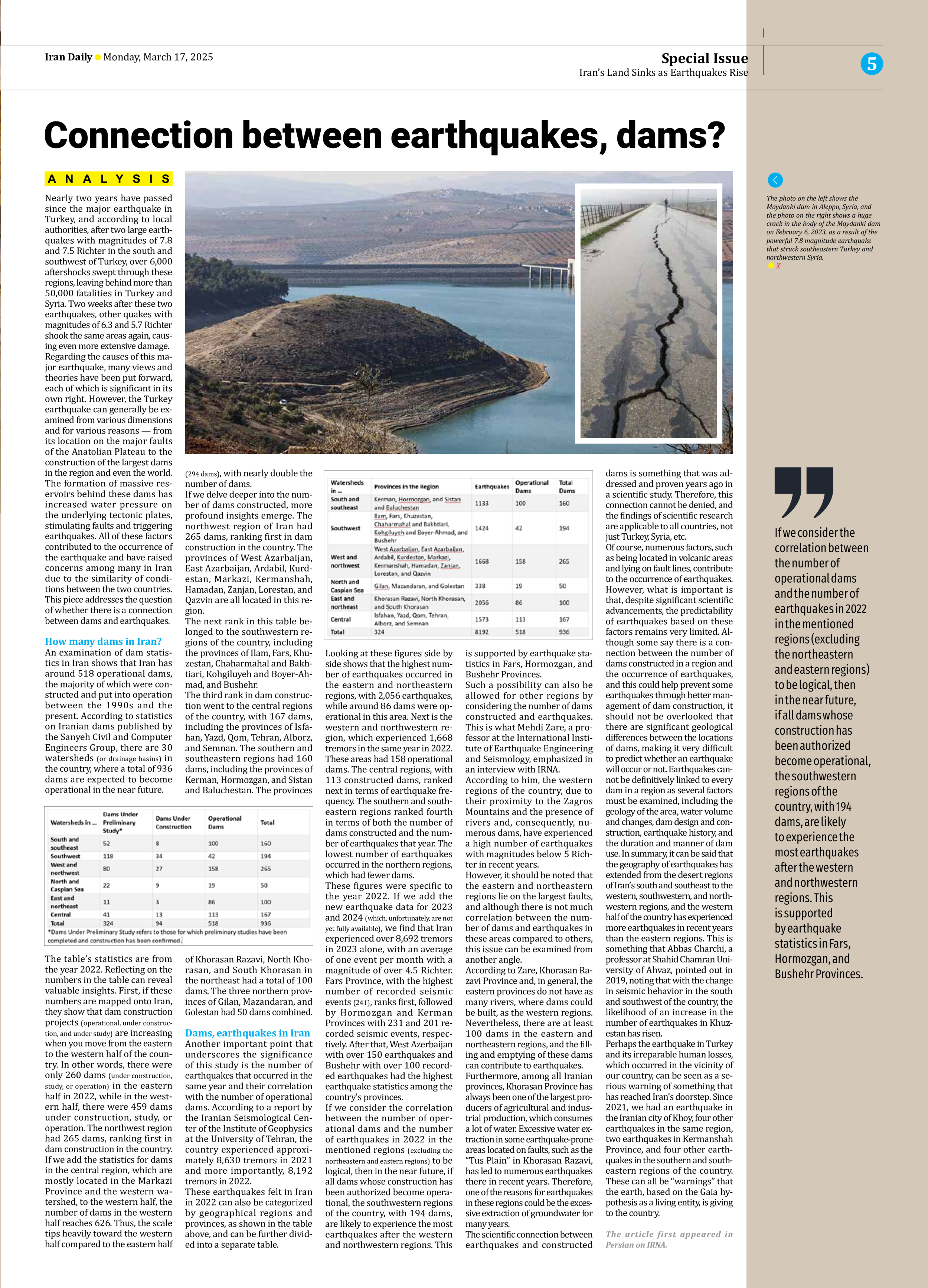
Connection between earthquakes, dams?
Nearly two years have passed since the major earthquake in Turkey, and according to local authorities, after two large earthquakes with magnitudes of 7.8 and 7.5 Richter in the south and southwest of Turkey, over 6,000 aftershocks swept through these regions, leaving behind more than 50,000 fatalities in Turkey and Syria. Two weeks after these two earthquakes, other quakes with magnitudes of 6.3 and 5.7 Richter shook the same areas again, causing even more extensive damage.
Regarding the causes of this major earthquake, many views and theories have been put forward, each of which is significant in its own right. However, the Turkey earthquake can generally be examined from various dimensions and for various reasons — from its location on the major faults of the Anatolian Plateau to the construction of the largest dams in the region and even the world. The formation of massive reservoirs behind these dams has increased water pressure on the underlying tectonic plates, stimulating faults and triggering earthquakes. All of these factors contributed to the occurrence of the earthquake and have raised concerns among many in Iran due to the similarity of conditions between the two countries. This piece addresses the question of whether there is a connection between dams and earthquakes.
How many dams in Iran?
An examination of dam statistics in Iran shows that Iran has around 518 operational dams, the majority of which were constructed and put into operation between the 1990s and the present. According to statistics on Iranian dams published by the Sanyeh Civil and Computer Engineers Group, there are 30 watersheds (or drainage basins) in the country, where a total of 936 dams are expected to become operational in the near future.
The table’s statistics are from the year 2022. Reflecting on the numbers in the table can reveal valuable insights. First, if these numbers are mapped onto Iran, they show that dam construction projects (operational, under construction, and under study) are increasing when you move from the eastern to the western half of the country. In other words, there were only 260 dams (under construction, study, or operation) in the eastern half in 2022, while in the western half, there were 459 dams under construction, study, or operation. The northwest region had 265 dams, ranking first in dam construction in the country.
If we add the statistics for dams in the central region, which are mostly located in the Markazi Province and the western watershed, to the western half, the number of dams in the western half reaches 626. Thus, the scale tips heavily toward the western half compared to the eastern half (294 dams), with nearly double the number of dams.
If we delve deeper into the number of dams constructed, more profound insights emerge. The northwest region of Iran had 265 dams, ranking first in dam construction in the country. The provinces of West Azarbaijan, East Azarbaijan, Ardabil, Kurdestan, Markazi, Kermanshah, Hamadan, Zanjan, Lorestan, and Qazvin are all located in this region.
The next rank in this table belonged to the southwestern regions of the country, including the provinces of Ilam, Fars, Khuzestan, Chaharmahal and Bakhtiari, Kohgiluyeh and Boyer-Ahmad, and Bushehr.
The third rank in dam construction went to the central regions of the country, with 167 dams, including the provinces of Isfahan, Yazd, Qom, Tehran, Alborz, and Semnan. The southern and southeastern regions had 160 dams, including the provinces of Kerman, Hormozgan, and Sistan and Baluchestan. The provinces of Khorasan Razavi, North Khorasan, and South Khorasan in the northeast had a total of 100 dams. The three northern provinces of Gilan, Mazandaran, and Golestan had 50 dams combined.
Dams, earthquakes in Iran
Another important point that underscores the significance of this study is the number of earthquakes that occurred in the same year and their correlation with the number of operational dams. According to a report by the Iranian Seismological Center of the Institute of Geophysics at the University of Tehran, the country experienced approximately 8,630 tremors in 2021 and more importantly, 8,192 tremors in 2022.
These earthquakes felt in Iran in 2022 can also be categorized by geographical regions and provinces, as shown in the table above, and can be further divided into a separate table.
Looking at these figures side by side shows that the highest number of earthquakes occurred in the eastern and northeastern regions, with 2,056 earthquakes, while around 86 dams were operational in this area. Next is the western and northwestern region, which experienced 1,668 tremors in the same year in 2022. These areas had 158 operational dams. The central regions, with 113 constructed dams, ranked next in terms of earthquake frequency. The southern and southeastern regions ranked fourth in terms of both the number of dams constructed and the number of earthquakes that year. The lowest number of earthquakes occurred in the northern regions, which had fewer dams.
These figures were specific to the year 2022. If we add the new earthquake data for 2023 and 2024 (which, unfortunately, are not yet fully available), we find that Iran experienced over 8,692 tremors in 2023 alone, with an average of one event per month with a magnitude of over 4.5 Richter. Fars Province, with the highest number of recorded seismic events (241), ranks first, followed by Hormozgan and Kerman Provinces with 231 and 201 recorded seismic events, respectively. After that, West Azerbaijan with over 150 earthquakes and Bushehr with over 100 recorded earthquakes had the highest earthquake statistics among the country’s provinces.
If we consider the correlation between the number of operational dams and the number of earthquakes in 2022 in the mentioned regions (excluding the northeastern and eastern regions) to be logical, then in the near future, if all dams whose construction has been authorized become operational, the southwestern regions of the country, with 194 dams, are likely to experience the most earthquakes after the western and northwestern regions. This is supported by earthquake statistics in Fars, Hormozgan, and Bushehr Provinces.
Such a possibility can also be allowed for other regions by considering the number of dams constructed and earthquakes. This is what Mehdi Zare, a professor at the International Institute of Earthquake Engineering and Seismology, emphasized in an interview with IRNA.
According to him, the western regions of the country, due to their proximity to the Zagros Mountains and the presence of rivers and, consequently, numerous dams, have experienced a high number of earthquakes with magnitudes below 5 Richter in recent years.
However, it should be noted that the eastern and northeastern regions lie on the largest faults, and although there is not much correlation between the number of dams and earthquakes in these areas compared to others, this issue can be examined from another angle.
According to Zare, Khorasan Razavi Province and, in general, the eastern provinces do not have as many rivers, where dams could be built, as the western regions. Nevertheless, there are at least 100 dams in the eastern and northeastern regions, and the filling and emptying of these dams can contribute to earthquakes.
Furthermore, among all Iranian provinces, Khorasan Province has always been one of the largest producers of agricultural and industrial production, which consumes a lot of water. Excessive water extraction in some earthquake-prone areas located on faults, such as the “Tus Plain” in Khorasan Razavi, has led to numerous earthquakes there in recent years. Therefore, one of the reasons for earthquakes in these regions could be the excessive extraction of groundwater for many years.
The scientific connection between earthquakes and constructed dams is something that was addressed and proven years ago in a scientific study. Therefore, this connection cannot be denied, and the findings of scientific research are applicable to all countries, not just Turkey, Syria, etc.
Of course, numerous factors, such as being located in volcanic areas and lying on fault lines, contribute to the occurrence of earthquakes. However, what is important is that, despite significant scientific advancements, the predictability of earthquakes based on these factors remains very limited. Although some say there is a connection between the number of dams constructed in a region and the occurrence of earthquakes, and this could help prevent some earthquakes through better management of dam construction, it should not be overlooked that there are significant geological differences between the locations of dams, making it very difficult to predict whether an earthquake will occur or not. Earthquakes cannot be definitively linked to every dam in a region as several factors must be examined, including the geology of the area, water volume and changes, dam design and construction, earthquake history, and the duration and manner of dam use. In summary, it can be said that the geography of earthquakes has extended from the desert regions of Iran’s south and southeast to the western, southwestern, and northwestern regions, and the western half of the country has experienced more earthquakes in recent years than the eastern regions. This is something that Abbas Charchi, a professor at Shahid Chamran University of Ahvaz, pointed out in 2019, noting that with the change in seismic behavior in the south and southwest of the country, the likelihood of an increase in the number of earthquakes in Khuzestan has risen.
Perhaps the earthquake in Turkey and its irreparable human losses, which occurred in the vicinity of our country, can be seen as a serious warning of something that has reached Iran’s doorstep. Since 2021, we had an earthquake in the Iranian city of Khoy, four other earthquakes in the same region, two earthquakes in Kermanshah Province, and four other earthquakes in the southern and southeastern regions of the country. These can all be “warnings” that the earth, based on the Gaia hypothesis as a living entity, is giving to the country.
The article first appeared in
Persian on IRNA.







